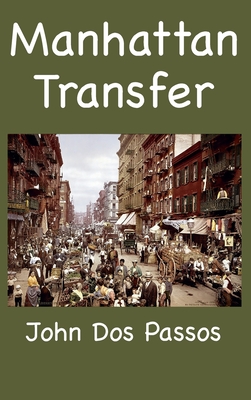Manhattan Transfer

Manhattan Transfer
Manhattan Transfer is an American novel by John Dos Passos published in 1925. It focuses on the development of urban life in New York City from the Gilded Age to the Jazz Age as told through a series of overlapping individual stories.
It is considered to be one of Dos Passos' most important works. The book attacks the consumerism and social indifference of contemporary urban life, portraying a Manhattan that is merciless yet teeming with energy and restlessness. The book shows some of Dos Passos' experimental writing techniques and narrative collages that would become more pronounced in his U.S.A. trilogy and other later works. The technique in Manhattan Transfer was inspired in part by James Joyce's Ulysses (1922) and T. S. Eliot's The Waste Land and bears frequent comparison to the experiments with film collage by Soviet director Sergei Eisenstein.
Sinclair Lewis described it as "a novel of the very first importance ... The dawn of a whole new school of writing." D. H. Lawrence called it "the best modern book about New York" he had ever read, describing it as "a very complete film ... of the vast loose gang of strivers and winners and losers which seems to be the very pep of New York." In a blurb for a European edition, Ernest Hemingway wrote that alone among American writers, Dos Passos has "been able to show to Europeans the America they really find when they come here."
197.99Lei
197.99Lei
Livrare in 2-4 saptamani
Descrierea produsului
Manhattan Transfer is an American novel by John Dos Passos published in 1925. It focuses on the development of urban life in New York City from the Gilded Age to the Jazz Age as told through a series of overlapping individual stories.
It is considered to be one of Dos Passos' most important works. The book attacks the consumerism and social indifference of contemporary urban life, portraying a Manhattan that is merciless yet teeming with energy and restlessness. The book shows some of Dos Passos' experimental writing techniques and narrative collages that would become more pronounced in his U.S.A. trilogy and other later works. The technique in Manhattan Transfer was inspired in part by James Joyce's Ulysses (1922) and T. S. Eliot's The Waste Land and bears frequent comparison to the experiments with film collage by Soviet director Sergei Eisenstein.
Sinclair Lewis described it as "a novel of the very first importance ... The dawn of a whole new school of writing." D. H. Lawrence called it "the best modern book about New York" he had ever read, describing it as "a very complete film ... of the vast loose gang of strivers and winners and losers which seems to be the very pep of New York." In a blurb for a European edition, Ernest Hemingway wrote that alone among American writers, Dos Passos has "been able to show to Europeans the America they really find when they come here."
Detaliile produsului











